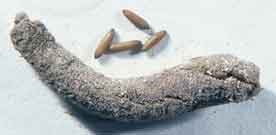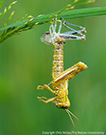home | spring garden | deciduous & confier garden
Differential Grasshopper
Differential grasshoppers are relatively large. Coloration ranges from brown to olive green and becomes darker with age. Hind legs are marked with black arrow-like markings and also have small spikes along the tibias. Females are larger than the males. Females lay eggs in clusters in soil capsules that are stuck together by a foamy secretion. These clusters usually contain 50-100 elongated, rusty-red colored eggs. Eggs are laid in early fall, and nymphs emerge in the spring and take about two months to reach adulthood. Adults have two sets of wings. The noise we hear from grasshoppers is produced by a grasshopper rubbing their hind wings and forewings together. Both nymphs and adults are detrimental to plants. They feed on leafy vegetation and can travel up to 10 miles a day in search for food.

|

|

|
